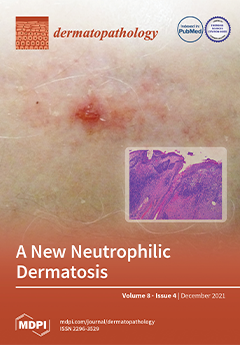Open AccessReview
Dedifferentiated Melanoma: A Diagnostic Histological Pitfall—Review of the Literature with Case Presentation
by
Gerardo Cazzato, Lucia Lospalluti, Anna Colagrande, Antonietta Cimmino, Paolo Romita, Caterina Foti, Aurora Demarco, Francesca Arezzo, Vera Loizzi, Gennaro Cormio, Sara Sablone, Leonardo Resta, Roberta Rossi and Giuseppe Ingravallo
Cited by 8 | Viewed by 2925
Abstract
Dedifferentiated melanoma is a particular form of malignant melanoma with a progressive worsening of the patient’s clinical outcome. It is well known that melanoma can assume different histo-morphological patterns, to which specific genetic signatures correspond, sometimes but not always. In this review we
[...] Read more.
Dedifferentiated melanoma is a particular form of malignant melanoma with a progressive worsening of the patient’s clinical outcome. It is well known that melanoma can assume different histo-morphological patterns, to which specific genetic signatures correspond, sometimes but not always. In this review we address the diagnostic difficulties in correctly recognizing this entity, discuss the major differential diagnoses of interest to the dermatopathologist, and conduct a review of the literature with particular attention and emphasis on the latest molecular discoveries regarding the dedifferentiation/undifferentiation mechanism and more advanced therapeutic approaches.
Full article
►▼
Show Figures





